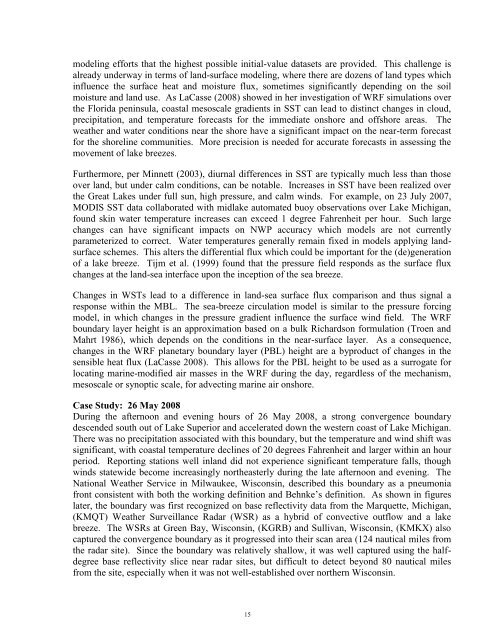Space Grant Consortium - University of Wisconsin - Green Bay
Space Grant Consortium - University of Wisconsin - Green Bay
Space Grant Consortium - University of Wisconsin - Green Bay
You also want an ePaper? Increase the reach of your titles
YUMPU automatically turns print PDFs into web optimized ePapers that Google loves.
modeling efforts that the highest possible initial-value datasets are provided. This challenge is<br />
already underway in terms <strong>of</strong> land-surface modeling, where there are dozens <strong>of</strong> land types which<br />
influence the surface heat and moisture flux, sometimes significantly depending on the soil<br />
moisture and land use. As LaCasse (2008) showed in her investigation <strong>of</strong> WRF simulations over<br />
the Florida peninsula, coastal mesoscale gradients in SST can lead to distinct changes in cloud,<br />
precipitation, and temperature forecasts for the immediate onshore and <strong>of</strong>fshore areas. The<br />
weather and water conditions near the shore have a significant impact on the near-term forecast<br />
for the shoreline communities. More precision is needed for accurate forecasts in assessing the<br />
movement <strong>of</strong> lake breezes.<br />
Furthermore, per Minnett (2003), diurnal differences in SST are typically much less than those<br />
over land, but under calm conditions, can be notable. Increases in SST have been realized over<br />
the Great Lakes under full sun, high pressure, and calm winds. For example, on 23 July 2007,<br />
MODIS SST data collaborated with midlake automated buoy observations over Lake Michigan,<br />
found skin water temperature increases can exceed 1 degree Fahrenheit per hour. Such large<br />
changes can have significant impacts on NWP accuracy which models are not currently<br />
parameterized to correct. Water temperatures generally remain fixed in models applying landsurface<br />
schemes. This alters the differential flux which could be important for the (de)generation<br />
<strong>of</strong> a lake breeze. Tijm et al. (1999) found that the pressure field responds as the surface flux<br />
changes at the land-sea interface upon the inception <strong>of</strong> the sea breeze.<br />
Changes in WSTs lead to a difference in land-sea surface flux comparison and thus signal a<br />
response within the MBL. The sea-breeze circulation model is similar to the pressure forcing<br />
model, in which changes in the pressure gradient influence the surface wind field. The WRF<br />
boundary layer height is an approximation based on a bulk Richardson formulation (Troen and<br />
Mahrt 1986), which depends on the conditions in the near-surface layer. As a consequence,<br />
changes in the WRF planetary boundary layer (PBL) height are a byproduct <strong>of</strong> changes in the<br />
sensible heat flux (LaCasse 2008). This allows for the PBL height to be used as a surrogate for<br />
locating marine-modified air masses in the WRF during the day, regardless <strong>of</strong> the mechanism,<br />
mesoscale or synoptic scale, for advecting marine air onshore.<br />
Case Study: 26 May 2008<br />
During the afternoon and evening hours <strong>of</strong> 26 May 2008, a strong convergence boundary<br />
descended south out <strong>of</strong> Lake Superior and accelerated down the western coast <strong>of</strong> Lake Michigan.<br />
There was no precipitation associated with this boundary, but the temperature and wind shift was<br />
significant, with coastal temperature declines <strong>of</strong> 20 degrees Fahrenheit and larger within an hour<br />
period. Reporting stations well inland did not experience significant temperature falls, though<br />
winds statewide become increasingly northeasterly during the late afternoon and evening. The<br />
National Weather Service in Milwaukee, <strong>Wisconsin</strong>, described this boundary as a pneumonia<br />
front consistent with both the working definition and Behnke’s definition. As shown in figures<br />
later, the boundary was first recognized on base reflectivity data from the Marquette, Michigan,<br />
(KMQT) Weather Surveillance Radar (WSR) as a hybrid <strong>of</strong> convective outflow and a lake<br />
breeze. The WSRs at <strong>Green</strong> <strong>Bay</strong>, <strong>Wisconsin</strong>, (KGRB) and Sullivan, <strong>Wisconsin</strong>, (KMKX) also<br />
captured the convergence boundary as it progressed into their scan area (124 nautical miles from<br />
the radar site). Since the boundary was relatively shallow, it was well captured using the halfdegree<br />
base reflectivity slice near radar sites, but difficult to detect beyond 80 nautical miles<br />
from the site, especially when it was not well-established over northern <strong>Wisconsin</strong>.<br />
15

















